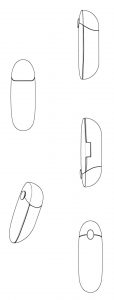How to make noise with your non-traditional trademark application
If word marks such as slogans, product names or business names and design marks such as logos are considered traditional marks, then what exactly are non-traditional trademarks? In July 2021, the Court of Justice of the European Union (CJEU) handed down two interesting decisions regarding such non-traditional trademarks. The first decision in Ardagh Metal Beverages Holdings GmbH & Co. KG v. EUIPO considered the registrable character of a sound, while the second in Guerlain v. EUIPO considered whether the three-dimensional shape of a product could be registered as a trademark.
The sound of a can being opened
In the Ardagh case, the CJEU confirmed the decision of the European Union Intellectual Property Office (EUIPO) to reject an application for registration of a trademark consisting of the sound made by a beverage can being opened, followed by a short silence and then a fizzing sound. The Court confirmed that the sound in question is first and foremost a functional element of the products for which registration was sought. As such, the average consumers of the goods would only perceive the sound as a technical solution connected to the handling of beverage containers, whether carbonated or not. Such a purely functional trademark cannot meet the required criteria for distinctiveness, and the Court confirmed that the application for registration of the sound sign was rightfully rejected on this basis.
The three-dimensional shape of a lipstick
This case provides an example of what the CJEU will accept as a distinctive non-traditional trademark. Guerlain, a well-known French cosmetics company, applied to register the three-dimensional sign below in association with lipstick products.

The EUIPO rejected the application on the basis that the mark applied for lacked distinctive character and was therefore unregistrable. Guerlain appealed the decision, and on July 14, 2021, the CJEU reversed the decision of the EUIPO.
The CJEU stated that, according to European jurisprudence, a three-dimensional shape will lack distinctiveness if it is close to the most likely shape that the product in question will take. Furthermore, the mere fact that the mark applied for is a variant of one of the usual shapes of the product in question is not sufficient to establish that the mark is distinctive. The decisive factor is whether the three-dimensional trademark allows the average consumer of the product in question to identify its origin and to distinguish the product from those of other companies.
In this case, the CJEU was of the view that the hull-like shape of Guerlain’s lipstick differs significantly from the usual shape of such products. The CJEU recognized the existence of a wide variety of shapes on the lipstick market but found that the evidence showed that the product’s’ usual shape was cylindrical. The CJEU disagreed with EUIPO’s argument that the shape in question is semi-cylindrical, finding instead that it is reminiscent of a boat hull. The Court stated further that the typical lipstick will have a flat surface allowing the product to stand upright, whereas Guerlain’s lipstick does not have a flat surface and cannot be placed upright. Finally, the Court found that the presence of the small oval embossed shape, like a hinge, on the lipstick in question further contributed to its uncommon appearance and differentiated it from the basic cylindrical shape of other products on the market.
The legislation in Canada differs from the European legislation, although distinctiveness plays a significant role in both jurisdictions. In Canada, non-traditional trademarks are also registrable under certain conditions, particularly when an applicant can demonstrate that the trademark is distinctive at the application’s filing date.
The Canadian Registrar historically allowed the registration of trademarks consisting only of sounds. Shapes of products or their containers could also be registered if such applied-for marks met the requirements of a distinguishing guise.
On June 17, 2019, amendments to Canada’s Trademarks Act came into force and the provisions related to distinguishing guise were repealed. Now, all non-traditional trademarks, namely a sound, a hologram, a moving image, a scent, a taste or a texture, a three-dimensional shape and a mode of packaging goods, now follow the same rules. Under the new legislation, if the applied-for trademark consists exclusively of such a sign, the Registrar will request evidence that it is distinctive at the application’s filing date. Furthermore, the trademark will not be registrable if “its features are dictated primarily by a utilitarian function”1 in relation to the goods or services in association with which it is used or proposed to be used.
If you require further details or have any questions regarding trademark protection or the registration process, please do not hesitate to contact a member of our team.
__________
1 Trademarks Act, RSC 1985, c T-13, s 12(2).
 Top of the page
Top of the page

